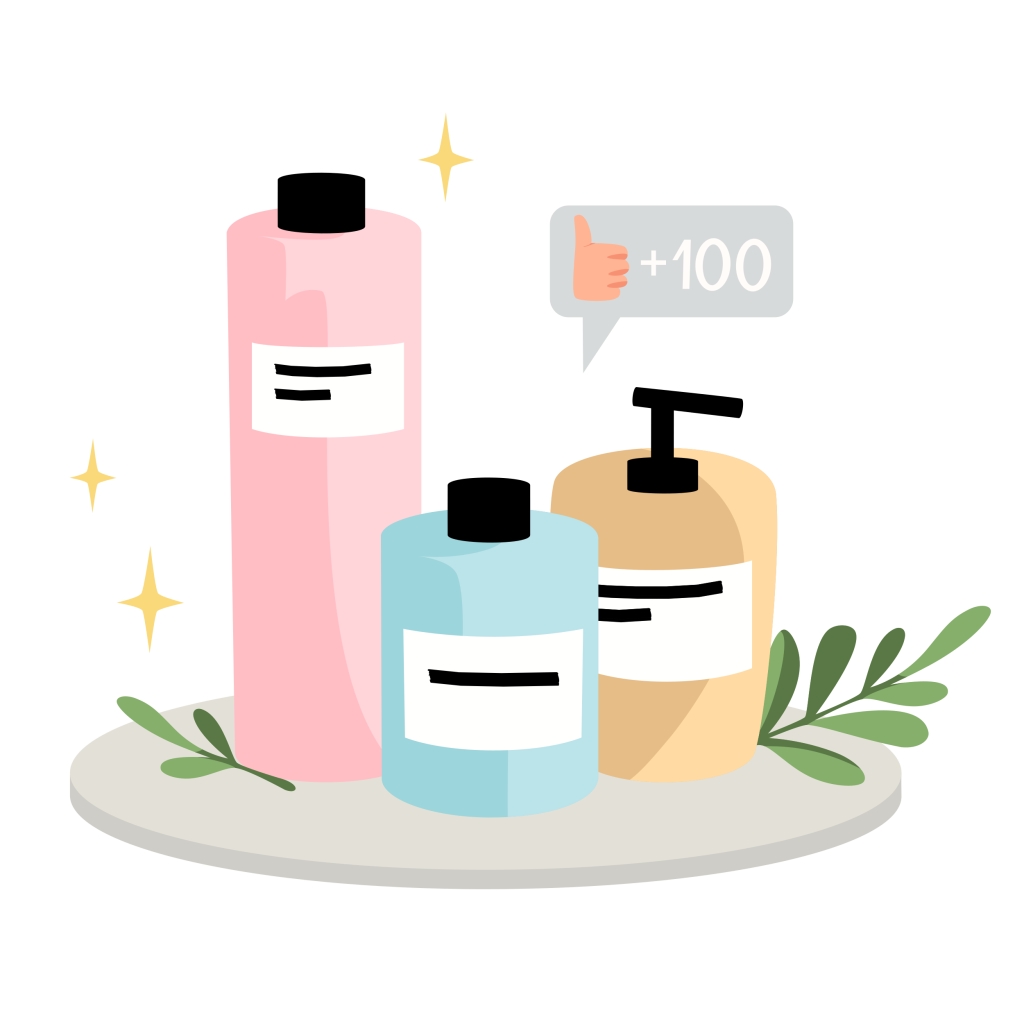The beauty market is booming, but so is the competition. Whether you’re planning to sell skincare you formulated yourself, source trending makeup products, or build a niche cosmetics brand, success online requires more than a pretty product page. Beauty is emotional, visual, and trust-driven. To win, you need strategy.
Want to learn how to sell beauty products online effectively? This guide covers everything from understanding your target market to leveraging social media. Dive in to discover actionable steps to boost your online beauty sales.
The Beauty Market Today

The beauty industry is continuously expanding, but the way customers discover, evaluate, and purchase products has changed dramatically. Today’s beauty market is shaped by digital influence rather than traditional advertising. People learn about products through TikTok routines, small creators on Instagram, skincare subreddits, and real-life before-and-after photos – not billboards or magazine spreads.
What makes this market especially dynamic today is the diversity of beauty needs and identities. There is no longer one beauty ideal or one definition of “good skin.” People want products that reflect their lived experience: their skin tone, texture, lifestyle, climate, and values. This fragmentation opens the door for smaller, more focused brands to thrive and build sustainable D2C brands that connect directly with their audiences.
Key Shifts Defining the Beauty Market
Consumers research deeply
They read ingredients, check pH levels, follow dermatologists, and expect transparent formulation logic.
Representation is non-negotiable
Cosmetics businesses that don’t offer inclusive shade ranges or meaningful diversity quickly lose relevance.
Functional skincare beats performative beauty
Products that work (and can show results) outperform those that rely on aesthetic appeal alone.
Self-care culture fuels beauty spending
Skincare products and body care are increasingly linked to emotional balance, rituals, and identity.
Communities drive influence
Reddit threads, TikTok subcultures, Discord groups, and micro-influencers shape trends more than legacy beauty publishers.
Can New Brands Still Succeed?
The short answer is yes. It’s easy to assume the beauty market is saturated, but saturation does not equal completion. Saturation simply means the broad categories are full. The real openings exist in the spaces between categories, where large brands cannot move fast enough and where cultural relevance changes faster than corporate messaging can adapt.
Smaller cosmetic entrepreneurs can leverage tools like marketplace SEO to build visibility on Amazon, Etsy, or niche platforms, and compete through authenticity, community, and unique problem-solving.
New brands succeed today because they:
- Communicate like real humans, not marketing departments
- Solve specific problems for specific people
- Create emotional worlds around their products
- Show results with transparency, not exaggerated claims
- Build community instead of chasing mass market visibility
The question is no longer “How do I sell beauty products online?”
It’s “How do I sell beauty that feels real, needed, and relatable?”
The fastest-growing segments in beauty
Today, they reflect a deeper emotional and lifestyle drivers. For instance:
Barrier repair / sensitive skin support
Consumers tired of irritation from strong actives now want comforting, gentle, clinically sensible skincare products.
Hybrid beauty (makeup with skincare benefits)
People want to simplify routines without compromising effect.
Men’s grooming & skincare
Once niche, now one of the fastest-growing demographics with low competition in mid-range.
Body care as self-care
Shower routines, body oils, exfoliants, aromatherapy – ritual-driven beauty is booming.
Clean, ethical, and sustainable formulations
But not “clean for marketing”; consumers now expect scientific clarity behind ingredient choices.
The rest of your strategy – product development, identity, fulfillment, content – comes from that understanding.
How Cosmetics Brands Make Money: Business Models Explained
Before choosing products, choose how your business will operate – your business model determines your margins, scaling ability, and brand identity. The 4 main models are considered below.
Private Label
This is one of the most popular starting points for new beauty brands. You purchase ready-made formulas from a manufacturer, add your branding, and customize packaging to make the product your own. It’s a balance between accessibility and control – lower investment than developing your own formula, but enough creative freedom to build a distinct brand. Startup costs are moderate, and profit margins are typically medium to high.
Custom Formulation
If you want complete control over ingredients, texture, and performance, custom formulation is your route. You’ll work with a cosmetic chemist or lab to develop an original formula from scratch. This gives you full ownership of your intellectual property and product uniqueness, but it comes with high upfront costs, testing requirements, and longer timelines. Brands pursuing a luxury or clinical positioning usually follow this path.
Wholesale / Resale
Here, you purchase existing branded products in bulk and resell them at a markup. It’s one of the simplest entry points since you don’t need to manufacture anything yourself. However, your profit margins and brand differentiation are limited because you’re selling someone else’s products. It’s ideal for retailers or beauty marketplaces, but less so for founders aiming to build a lasting brand identity.
Dropshipping
The easiest and cheapest way to start — but also the hardest to scale. With dropshipping, you act as the middle layer between customers and suppliers. You don’t handle stock, packaging, or shipping; instead, products are sent directly from your supplier to the customer. The low startup cost comes at the expense of minimal control, razor-thin margins, and potential quality or delivery issues. It can work for market testing, but rarely for building a premium cosmetics brand.
If your goal is to build a brand, not just “sell products,” wholesale and dropshipping are temporary entry models, not long-term strategies. For example, if you already know how to sell supplements online, the logic is similar: private label gives you control and higher profit potential, while wholesale limits your growth.
Brand = Margin.
Commodity products = low margin, constant price competition.
Successful Brand Examples
These real-world examples show how different beauty brands grew using each business model. Use them as inspiration to understand what model aligns with your goals, budget, and long-term brand vision.
Private Label Examples
Private label brands launch quickly by using ready-made formulas and focusing their energy on branding, aesthetics, and community-building.
- Kylie Cosmetics (early launch): fast go-to-market using existing formulas + heavy brand identity.
- Morphe: grew via influencer collaborations and strong visual marketing rather than unique formulations.
- ColourPop (early years): rapid product drops thanks to private-label-style production speed.
- Madeby Mitchell: built social-first brand presence while scaling through pre-existing formulas.
Small-Batch / Handmade Examples
These brands typically begin by producing in small volumes, often highlighting natural ingredients, craft processes, and storytelling.
- Herbivore Botanicals: started with handmade, minimalist formulas crafted in-house.
- Soap & Glory (early start): focused on quirky storytelling and small-batch production before scaling.
- FARMSKIN: fruit- and farm-inspired skincare produced in smaller controlled batches.
- Etsy-origin artisan brands: thousands of micro-brands that emphasize craftsmanship over scale.
Custom Formulation Examples
Custom-formulated brands invest heavily in R&D, clinical testing, and ingredient innovation to build authority and justify higher price points.
- Drunk Elephant: “clean clinical” positioning powered by proprietary ingredient combinations.
- Paula’s Choice: science-first brand built on evidence-based actives and research-backed formulas.
- The Ordinary / DECIEM: made active ingredients mainstream through transparent, lab-developed formulations.
- SkinCeuticals: biotech-grade formulations with strong clinical validation.
The Step-by-Step Process: How to Start Selling Cosmetics Online

Now that we understand the market, lets look at a few actionable steps for launching your beauty business.
1. Understand Your Target Market
Before choosing products or designing packaging, you need clarity on who your customer actually is. The beauty industry is incredibly emotional and personal: people buy based on identity, lifestyle, and how products make them feel. So defining your target audience is not about checking boxes like age and gender – it’s about understanding their daily routines, frustrations, values, and desires.
A helpful way to think about this is:
You are not selling beauty products. You are selling outcomes, confidence, and transformation.
What Shapes Beauty Preferences?
Instead of generic demographics of target audience, focus on:
- Skin or hair concerns (acne, dryness, frizz, hyperpigmentation)
- Lifestyle constraints (busy routines, travel, gym-friendly products)
- Values (vegan, fragrance-free, luxury ingredients, sustainable packaging)
- Shopping behavior (impulse TikTok buyer vs. ingredient researcher)
Customer behavior data – like browsing trends, purchase frequency, and eCommerce metrics and KPIs can help you refine your messaging and product selection more accurately than guesswork.
For example: A 45-year-old man looking for a simple routine is not the same customer as a 22-year-old skincare hobbyist who reads every ingredient label. They require completely different messaging and product formats.
2. Choose the Best eCommerce Platform
Choosing an eCommerce platform is a branding decision. Your website is your flagship retail experience. Whether you build a Shopify store, use WordPress with WooCommerce, or integrate with social shopping tools like Fulfilled by TikTok, your online store must offer seamless checkout, responsive design, and secure payment methods.
| Platform | Best For | Why? |
|---|---|---|
| Shopify | Beauty brands planning to grow | Easy to scale, apps for subscriptions, warehouses, influencer integration |
| WooCommerce | Brands already using WordPress | Highly customizable but requires setup skill |
| Squarespace | Minimal product lines or simple catalogs | Beautiful templates, but fewer growth tools |
If beauty is visual and emotional, then:
- Your product pages must feel inviting
- Your imagery must feel sensory
- Your checkout must feel effortless
Make It Seamless on Mobile
Most beauty purchases happen on phones, often while scrolling in bed or on public transport.
So your site should:
- Load quickly
- Show textures clearly
- Have zero confusing menus
If your product page is difficult to navigate on mobile, every other decision you make becomes irrelevant.
3. Build Your Online Store

How your store looks and feels matters just as much as the product itself. In beauty, packaging is the first impression, photography communicates texture and finish, and your website layout shapes the overall experience. The goal is to make browsing your store feel like entering a world, not scrolling a catalog.
What to Show on Product Pages
- Texture close-ups (so customers can imagine feel + finish)
- Swatches on multiple skin tones, product descriptions and product detail pages
- Short application clips (5–12 seconds is enough)
- Clear benefit-focused headlines
- Routine placement (AM/PM, before makeup, layered with X)
Tip: If someone can’t tell what the product does within 5 seconds, the page needs rewriting.
Make Navigation Based on Benefits, Not Just Categories
Rather than organizing your store by broad product categories like Skincare, Haircare, or Makeup, try grouping items based on the results or needs they address. For example, labels such as For Dry Skin, For Dewy Finishes, or For Strengthening Damaged Hair help customers immediately recognize which products are relevant to them. This benefit-led navigation makes browsing more intuitive, reduces hesitation, and ultimately increases the customer loyalty.
Implement Secure Payment Methods
Credit card processing setup is crucial for selling beauty products online. During checkout, beauty sellers should offer options like credit cards and PayPal to facilitate customer purchases. Diverse payment methods cater to different customer preferences and enhance the shopping experience.
Secure payment options such as PayPal, credit cards, and buy-now-pay-later services, as well as local payment methods or even Shopify crypto payments, should be provided.
4. Create a Strong Cosmetic Products Brand Identity
A strong identity distinguishes you in a crowded market. It consists of vibe, message, and customer story. Communicate the significance of your product and differentiate it from competitors.
Include the journey behind your brand, inspiration, and product impact in your story. Consider the following for your brand:
- A distinctive business name and logo to help potential customers find and recognize your products.
- Representation of the lifestyle you aspire to.
- Conveyance of the emotions you wish to evoke in your audience.
Develop a Unique Selling Proposition
Specific brand messaging not only communicates your identity but also sets you apart from competitors in online sales. Your brand’s value proposition should clearly define the benefits of your products and address customer pain points.
Effectively communicating the use of natural ingredients can enhance consumer trust and differentiate a brand from its competitors. A unique selling proposition (USP) is vital for standing out in the competitive beauty market.
Design Memorable Packaging
Attractive packaging not only grabs attention but also creates a lasting impression, influencing customer purchasing decisions. Packaging should reflect your brand identity and meet labeling requirements.
5. Provide Exceptional Customer Service

Customer service plays a major role in whether the target audiences comes back after their first purchase. Since beauty is personal and often tied to confidence and self-expression, people want to feel supported if they have questions about shade matching, application, or skin compatibility. Being honest, clear, and approachable helps create trust – and potential customers remember brands that make them feel understood.
It also helps to make it obvious how someone can reach you. If support feels hidden or slow, customers will simply move on. Clear communication channels and a straightforward return policy can remove hesitation and make the entire shopping experience feel smoother and safer. Many logistics providers use service level agreements to maintain predictable performance – something beauty sellers should mirror through reliable response times and fast returns.
Keep in mind:
- Make your contact options easy to find (email + live chat + social DMs).
- Use a friendly, human tone when responding – no robotic scripts.
- Write your return policy in simple language and place it directly on product pages.
6. Utilize Data Analytics
Data analytics are crucial for understanding customers and refining marketing strategies. Detailed customer personas, based on demographics and purchasing behavior, guide product marketing. Monitoring performance indicators and track key performance indicators like conversion rates and customer acquisition costs helps evaluate marketing effectiveness.
Sales data offers direct insight into overall product performance and informs future strategy.
Monitor Key Performance Indicators (KPIs)
Use data analytics to track performance, understand customer behavior, and refine strategies. Test various elements of your website and marketing campaigns to identify what works best for your audience. High attention but low conversion rates might indicate a need for better product descriptions or images.
Cart abandonment rates can suggest necessary improvements in the checkout process.
Perform A/B Testing
A/B testing helps brands experiment with various marketing strategies to identify the most effective approaches. A/B testing can improve customer engagement by analyzing different marketing messages or design elements.
A/B testing aids in determining the most effective elements of marketing campaigns by comparing variations. This method refines your marketing efforts and improves overall performance.
Leveraging Social Media Marketing Strategies
Social media is where beauty brands are built today. Customers want to see how products look, feel, and perform in real life, and social media platforms like TikTok and Instagram make this possible in seconds. Makeup swatches, skincare routines, and transformation videos are naturally shareable, which is why beauty consistently performs above average in engagement across social platforms. When done well, social media advertising and content doesn’t just generate awareness – it builds trust and community.
Choose Platforms Based on How Your Audience Shops
Not all platforms serve the same purpose, so focusing your energy matters more than being everywhere.
| Platform | Best For | What Works Well |
|---|---|---|
| Brand identity + aesthetics | Reels, UGC, before/afters | |
| TikTok | Discovery + virality | Tutorials, quick routines, texture videos |
| Searchable inspiration | Moodboards, routine breakdowns | |
| YouTube | Education + storytelling | Skincare journeys, deep dives |
Tip: It’s better to be excellent on one platform than average on four.
Create Content That Shows Real Use
People connect with what they can imagine themselves using. In the beauty industry, your content should help them see when and why they would pick your product.
Good content formats for beauty brands include:
- “Get ready with me” routines
- Swatches on different skin tones
- Quick “how to apply” clips
- Before → after → routine steps
- Customer reviews filmed casually, not scripted
This type of content isn’t about perfection, it’s about being relatable.
Collaborate With Influencers (Start Small)

Micro-influencers (2K–50K followers) are often your best partners. Their audiences trust them, and the content they create feels more genuine than polished brand campaigns. It’s also far more affordable, meaning you can test quickly and see what resonates.
What matters isn’t follower count, it’s:
- Engagement quality
- Alignment with your brand aesthetic
- Whether their audience actually buys things, not just likes posts
Look for beauty influencers who already talk about skincare, routines, or lifestyle, not just anyone with reach.
The Real Costs of Starting a Beauty Brand
The cost of launching a beauty brand depends mostly on three decisions:
- Formula type: private label (ready-made) or custom lab formulation
- Packaging tier: stock, semi-custom, or fully custom
- Batch size: how many units you order at once (this is where cost changes the most)
To make this practical and concrete, let’s walk through a realistic online store small launch example – one hero product with semi-custom packaging, in a first batch of ~150 units. This is the most common and financially sensible way to start.
| Expense Category | Private Label (150 units) | Small-Batch / Handmade (150 units) | Custom Formulation (150 units) |
|---|---|---|---|
| Formula / Manufacturing | €450–€900 | €130–€350 (raw ingredients + supplies) | €4,500+ (R&D + stability + testing) + €450–€900 manufacturing |
| Packaging + Labels | €180–€480 (stock bottle + custom labels) | €180–€480 (same options) | €1,000–€3,000 (semi-custom or custom molded packaging) |
| Regulatory Compliance (required in EU / recommended globally) | €250–€500 | €250–€500 | €250–€700 (more complex formulas = higher review time) |
| Website Setup (Shopify theme + setup) | €120–€350 | €120–€350 | €350–€1,500 (custom design expected at this level) |
| Photography + Short Video Content | €250–€900 | €200–€700 | €600–€2,500 (professional studio or creative direction) |
| Marketing (Micro-Influencer Gifting + Launch Content) | €100–€400 | €100–€400 | €500–€4,000 (paid collaborations + launch campaign) |
| Packaging Materials for Shipping (mailers, boxes, filler) | €60–€150 | €60–€150 | €100–€300 |
| Total Estimated Launch Cost | €1,410–€3,280 | €1,040–€2,930 | €7,450+ |
So, which model should you choose?
It depends less on your budget and more on your stage and strategy.
If you’re launching your first brand or testing an idea, private label is usually the most sensible starting point. It allows you to create a professional, cohesive product with controlled costs and a manageable first batch size. To make this step easier, you can partner with a private-label supplier that specializes in beauty products. For example, a private label cosmetics manufacturer in Europe Merywood provides ready-to-go formulas and small-batch production with the option to customize packaging and branding. This allows new brands to launch quickly, without the heavy upfront investment of developing products from scratch.
If your vision is more artisanal, rooted in craft storytelling, or limited-run drops, small-batch production may align better – but you’ll need to consider early whether and how you’ll transition to outsourcing, if growth becomes the goal. Meanwhile, custom formulation is best reserved for brands with a clearly defined concept, those who own online store, or have a strong differentiation and a longer runway – it’s a strategic move when you already know what makes your product worth choosing over similar options.
How to Handle Storage, Shipping, and Order Fulfillment
Once your products are ready, you need a clear plan for how they will be stored, packed, and delivered. In beauty, this step matters more than many new brands expect. Skincare and beauty products are frequently repeat-purchase items -which means that a great delivery experience can directly translate into recurring revenue.
There are three common approaches when starting out:
- Fulfill orders yourself (at home or in a small workspace)
Good for early-stage brands testing demand. Low upfront cost, but time-consuming as orders increase. - Use a local warehouse or courier service
Works if you want faster delivery in a specific region, such as one country or city. - Use a third-party fulfillment partner
Best once you begin receiving regular daily orders or want to ship efficiently across multiple countries.
If you don’t want to handle storage, picking, packing, and shipping yourself, you can use a fulfillment provider. For example, WAPI helps beauty brands with cosmetics fulfillment, as well as storing products in their European warehouses and shipping orders across the EU and UK with fast delivery and automated tracking. This makes scaling easier, reduces delivery times, and frees you to focus on branding and product development instead of logistics.
Staying Updated With Beauty Trends

Beauty evolves quickly, and customer expectations shift just as fast. Keeping an eye on emerging ingredients, beauty products, application styles, or routine habits helps you stay relevant rather than reactive. Trends often begin in creator communities long before they reach mainstream retailers, so watching platforms like TikTok, Reddit skincare threads, or niche Instagram accounts can give you early insight into what customers are excited about next.
Tracking bestseller lists on retailers like Sephora, Douglas, LookFantastic, or niche online marketplaces can also help you spot patterns. If certain product formats (like skin barrier repair creams or lip oils) consistently show up across platforms, it’s a signal that demand is wide enough to be sustainable – not just hype.
Follow Industry News
Beauty industry publications, newsletters, and ingredient databases are valuable for understanding the why behind trends – not just the trend itself. Reading about regulatory updates, new formulation technologies, and shifts in consumer values keeps you from making decisions based solely on what is visually popular. Staying informed allows you to position your products more strategically, refine messaging, and adjust pricing or packaging decisions before competitors do.
Engage With Your Audience
Trend awareness becomes much more powerful when combined with real customer feedback. Comment sections, review platforms, DMs, and community discussions provide direct insight into what your audience actually wants more or less of. Regularly responding, asking questions, and encouraging customers to share their routines builds trust and helps your brand evolve in a way that feels natural and customer-led. When customers feel heard, they become repeat buyers – and often your best advocates.
Conclusion
Starting a beauty business today is less about having a perfect plan and more about learning in motion. The brands that succeed aren’t always the biggest or the ones with the most products – they’re the ones that understand their audience, communicate clearly, and stay adaptable as trends and customer needs shift. Begin with one product you believe in, build a successful beauty brand around it, and let your customers guide the next steps. With patience, consistency, and thoughtful execution, selling beauty products online can grow from an idea into a lasting and recognizable brand.
Frequently Asked Questions
How do I identify my target market to sell beauty products online?
To effectively identify your target market for selling cosmetics online, conduct thorough market research to understand demographics, preferences, and purchasing behavior, and create detailed customer personas for more precise targeting.
What are the best eCommerce platforms for selling beauty products?
Shopify, WordPress (with WooCommerce), and Squarespace are excellent eCommerce platforms for selling beauty products due to their scalability, user-friendliness, and focus on customer experience. Selecting the right platform will enhance your online presence and sales potential.
How important is social media marketing for beauty brands?
Social media marketing is essential for cosmetics business as it leverages visual appeal and fosters community engagement, making platforms like Instagram, TikTok, and Pinterest particularly valuable for reaching and connecting with audiences.
What are some effective SEO strategies for an online beauty store?
To enhance your online beauty store’s SEO, focus on thorough keyword research, optimize on-page elements such as titles and headers, and actively build backlinks. These strategies will significantly improve your search engine rankings and visibility.
How can I provide excellent customer service for my online store?
To provide exceptional customer service for your online beauty store, offer multiple contact options, establish a clear return policy, and handle customer feedback transparently and respectfully. This approach will help build trust and loyalty with your customers.



 Community
Community
